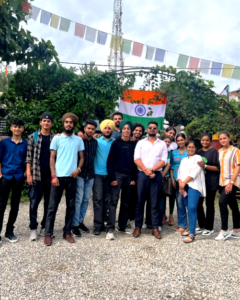Ambergris
A The name ambergris is derived from the Spanish “ambar gris”, ambar meaning amber and gris meaning grey, thus the name signifies grey amber. Theuse of ambergris in Europe is now entirely confined to perfumery-as a material of perfumery. Its high price varies from$15 to$25 an ounce, though it formerly occupied on inconsiderable place in medicine. Ambergris was also decorated and worn as jewelry, particularly during the Renaissance.It occupies a very important place in the perfumery of the East, and there it is also used in pharmacy and as a flavouring material in cookery.
B Amber, however, is quite a different substance from ambergris and this discrepancy has puzzled some people. Amber is the fossilized resin from trees that was quite familiar to Europeans long before the discovery of the New World, and prized for jewelry. Although considered a gem, amber is a hard, transparent and wholly-organic material derived from the resin of extinct species of trees. In the dense forests of the Middle Cretaceous and Tertiary periods, between 10 and 100 million years ago, these resin-bearing trees fell and were carried by rivers to coastal regions. There, the trees and their resins became covered with sediment, and over millions of years the resin hardened into amber.
C Ambergris and amber are related by the fact that both wash up on beaches. Ambergris is a solid, waxy and flammable substance of a dull 2rey or blackish color, with the shades being variegated 1ike marble. It possesses a peculiar sweet,earthy odour not unlike isopropyl alcohol. It is now known to be a morbid secretion formed in the intestines of the sperm whale, found in the Atlantic and Pacific oceans. Being a very lightweight material, ambergris is found floating upon the sea, on the sea coast, or in the sand near the sea coast.It is met with in the Atlantic Ocean, on the coasts Of Brazil and Madagascar; also on the coast Of Africa, of the East Indies, China, Japan, and the Molucca Islands; but most of the ambergris which is brought to England comes from the Bahama Islands. It is also sometimes found in the abdomen of whales; it is always in lumps in various shapes and sizes, weighing from 1/ 2 oz. to 100 or more lb. A piece which the Dutch East India Company bought from the King of Tydore weighed 182 lb. An American fisherman from Antigua found, Inside a whale, about 52 1eagues south-east from the Windward Islands, a piece of ambergris which weighed about l 30 lb, and sold for 500 sterling.
D Like many other substances regarding the origin of which there existed some obscurity or mystery, ambergris in former times possessed a value, and had properties attributed to it, more on account of the source from which it was drawn than from its inherent qualities. Many ridiculous hypotheses were started to account for its origin, and among others it was conjectured to be the solidified foam of the sea, a fungous growth in the ocean similar to the fungi which form on trees.
E The true source and character of ambergris was first satisfactorily established by Dr. Swediaur in a communication to the Royal Society. It was found by Dr. Swediaur that ambergris very frequently contained the horny mandibles or beaks of the squid, on which the sperm whales are known to feed. That observation, in connection with the fact of ambergris being frequently taken from the intestines of the sperm whale, sufficiently proved that the substance is produced by the whale’s intestine as a means of facilitating the passage of undigested hard, sharp beaks of squid that the whale has eaten.
F It was further observed that the whales in which ambergris was found were either dead or much wasted and evidently in a sickly condition. From this it was inferred that ambergris is in some way connected with a morbid condition of the sperm whale. Often expelled by vomiting, ambergris floats in chunks on the water and is of a deep grey colour, soft consistence, and an offensive, disagreeable smell. Following months to years of photo-degradation and oxidation in the ocean, this precursor gradually hardens, developing a dark grey or black colour, a crusty and waxy texture, and a peculiar odour that is at once sweet, earthy, marine, and animalist. Its smell has been described by many as a vastly richer and smoother version of isopropanol without its stinging harshness.
G In that condition its specific gravity ranges from 0.780 to 0.926. It melts at a temperature of about 145 F into a fatty yellow resin-like liquid.It is soluble in ether, volatile and fixed oils, but only feebly acted on by acids. By digesting in hot alcohol, a peculiar substance termed ambrein is obtained. In chemical constitution ambrein very closely resembles cholesterin, a principle found abundantly in biliary calculi . It is therefore more than probable that ambergris, from the position in which it is found and its chemical constitution, is a biliary concretion analogous to what is formed in other mammals.
H The industries founded on ambergris resulted in the slaughter of sperm whales almost to extinction. Sperm whales were killed in two massive hunts, the Moby Dick whalers who worked mainly between 1740-1 880, and the modem whalers whose operations peaked in 1 964, when 29,255 were killed. Most recent estimates suggest a global population of about 360,000 animals down from about 1,100,000 before whaling. In the 20th century, 90% of ambergris was derived in the processing of killing sperm whales. To this day, ambergris is still the most expensive product in the whole body of sperm whale. Depending on its quality, raw ambergris fetches approximately 20 USD per gram. In the United States, possession of any part of an endangered species-including ambergris that has washed ashore-is a violation of the Endangered Species Act of 1978.
I Historically, the primary commercial use of ambergris has been in fragrance chemistry. However, it is difficult to get a consistent and reliable supply of high quality ambergris. Due to demand for ambergris and its high price, replacement compounds have been sought out by the fragrance industry and chemically synthesized. The most important of these is Ambrox, which has taken its place as the most widely used amber odorant in perfume manufacture. Procedures for the microbial production of Ambrox have also been devised.
Questions 1-5
Classify the following statement as applying to
A Ambergris only
B Amber only
C Both amber and ambergris
D Neither amber nor ambergris
1. very expensive
2. food flavor
3. used as currency
4. referred to in a communication
5. could be seen through
Questions 6-9
Complete the Summary paragraph described below in boxes 6-9 on your answer sheet. Write the correct answer with ONE WORD.
The formation of ambergris experiences several stages. First, when sperm whale eats the hard and sharp (6)……………. of squid, its intestine will produce ambergris to facilitate the (7)…………………. Then, ambergris can be (8)……………….. up by sperm whale and float on the water. After months of exposure on air, it (9)…………… and the color turns dark grey or black.
Question 10-13
Do the following statements agree with the information given in the passage? In boxes 10-13 on your sheet, write
TRUE if the statement agrees with the information
FALSE if the statement contradicts the information
NOT GIVEN if there is no information on this
10. In the 20th century, most ambergris was made in the process of killing sperm whale.
11. Ambergris’s cost increased recently.
12. Ambergris still remains in the perfume making.
13. Ambergris is still the most important amber odorant in perfume manufacture.
Language Strategy in Multinational Company
A The importance of language management in multinational companies has never been greater than today. Multinationals are becoming ever more conscious of the importance of global coordination as a source of competitive advantage and language remains the ultimate barrier to aspirations of international harmonization. Before attempting to consider language management strategies, companies will have to evaluate the magnitude of the language barrier confronting them and in doing so they will need to examine it in three dimensions: the Language Diversity, the Language Penetration and the Language Sophistication. Companies next need to turn their attention to how they should best manage language. There is a range of options from which MNCs can formulate their language strategy.
B Lingua Franca: The simplest answer, though realistic only for English speaking companies, is to rely on ones native tongue. As recently as 1991 a survey of British exporting companies found that over a third used English exclusively in dealings with foreign customers. This attitude that —one language fits all has also been carried through into the Internet age. A survey of the web sites of top American companies confirmed that over half made no provision for foreign language access, and another found that less than 10% of leading companies were able to respond adequately to emails other than in the company‘s language. Widespread though it is however, reliance on a single language is a strategy that is fatally flawed. It makes no allowance for the growing trend in Linguistic Nationalism whereby buyers in Asia, South America and the Middle East in particular are asserting their right to —work in the language of the customer!. It also fails to recognize the increasing vitality of languages such as Spanish, Arabic and Chinese that overtime are likely to challenge the dominance of English as a lingua franca. In the IT arena it ignores the rapid globalization of the Internet where the number of English-language ecommerce transactions, emails and web sites, is rapidly diminishing as a percentage of the total. Finally, the total reliance on a single language puts the English speaker at risk in negotiations. Contracts, rules and legislation are invariably written in the local language, and a company unable to operate in that language is vulnerable.
C Functional Multilingualism: Another improvised approach to Language is to rely on what has been termed —Functional Multilingualism!. Essentially what this means is to muddle through, relying on a mix of languages, pidgins and gestures to communicate by whatever means the parties have at their disposal. In a social context such a shared effort to make one another understand might be considered an aid to the bonding process with the frustration of communication being regularly punctuated by moments of absurdity and humor. However, as the basis for business negotiations it appears very hit-and-nuts. And yet Hagen‘s recent study suggests that 16% of international business transaction; are conducted in a —cocktail of languages.! Functional Multilingualism shares the same defects as reliance on a lingua franca and increases the probability of cognitive divergence between the parties engaged in the communication.
D External Language Resources: A more rational and obvious response to the language barrier is to employ external resources such as translators and interpreters, and certainly there are many excellent companies specialized in these fields. However, such a response is by no means an end to the language barrier. For a start these services can be very expensive with a top Simultaneous Interpreter, commanding daily rates as high as a partner in an international consulting company. Secondly, any good translator or interpreter will insist that to be fully effective they must understand the context of the subject matter. This is not always possible. In some cases it is prohibited by the complexity or specialization of the topic. Sometimes by lack of preparation time but most often the obstacle is the reluctance of the parties to explain the wider context to an outsider. Another problem is that unless there has been considerable pre-explaining between the interpreter and his clients it is likely that there will be ambiguity and cultural overtones in the source messages the interpreter has to work with. They will of course endeavor to provide a hifidelity translation but in this circumstance the interpreter has to use initiative and guess work. This clearly injects a potential source of misunderstanding into the proceedings. Finally while a good interpreter will attempt to convey not only the meaning but also the spirit of any communication, there can be no doubt that there is a loss of rhetorical power when communications go through a third party. So in situations requiring negotiation, persuasion, humor etc. the use of an interpreter is a poor substitute for direct communication.
E Training: The immediate and understandable reaction to any skills shortage in a business is to consider personnel development and certainly the language training industry is well developed. Offering programs at almost every level and in numerous languages. However, without doubting the value of language training no company should be deluded into believing this to be assured of success. Training in most companies is geared to the economic cycle. When times are good, money is invested in training. When belts get tightened training is one of the first —luxuries! to be pared down. In a study conducted across four European countries, nearly twice as many companies said they needed language training in coming years as had conducted training in past years. This disparity between —good intentions! and —actual delivery!, underlines the problems of relying upon training for language skills. Unless the company is totally committed to sustaining the strategy even though bad times, it will fail.
F One notable and committed leader in the field of language training has been the Volkswagen Group. They have developed a language strategy over many years and in many respects can be regarded as a model of how to manage language professionally. However, the Volkswagen approach underlines that language training has to be considered a strategic rather than a tactical solution. In their system to progress from —basics! to —communications competence! in a language requires the completion of 6 language stages each one demanding approximately 90 hours of refresher course, supported by many more hours of self-study, spread over a 6-9 month period. The completion of each stage is marked by a post-stage achievement test, which is a pre-requisite for continued training. So even this professionally managed program expects a minimum of three years of fairly intensive study to produce an accountant. Engineer, buyer or salesperson capable of working effectively in a foreign language. Clearly companies intending to pursue this route need to do so with realistic expectations and with the intention of sustaining the program over many years. Except in terms of —brush-up! courses for people who were previously fluent in a foreign language, training cannot be considered a quick fix and hence other methods will have to be considered.
Questions 14-19
Complete the following summary of the whole paragraphs of reading passage, choosing ONE WORD from the passage only.
Language Diversity, the Language Penetration and the Language Sophistication. Companies next need to turn their attention to how they should best manage language. There is a range of options from which (14)…………….. can formulate their language strategy. This attitude that —one language fits(15)…………….l has also been carried through into the Internet age. Widespread though it is however, reliance on a single language is a strategy that is fatally flawed. It makes no allowance for the growing trend in Linguistic Nationalism whereby (16)…………… in Asia, South America and the Middle East in particular are asserting their right to —work in the language of the customer. In some cases it is prohibited by the (17)…………… or specialization of the topic. Sometimes by lack of preparation time but most often the obstacle is the reluctance of the parties to explain the wider context to an outsider. The immediate and understandable reaction to any skills (18)……………. in a business is to consider personnel development and certainly the language training industry is well developed. Offering programs at almost every level and in numerous languages. The completion of each stage is marked by a post-stage (19)…………….. test, which is a pre-requisite for continued training.
Questions 20-26
Answer the questions below. Choose NO MORE THAN THREE WORDS AND/OR A NUMBER from the passage for each answer.
20. What understandable reaction does Training pay attention to according to the author?
21. In what term does the writer describe training during economy depression?
22. What contribution does Volkswagen Group do for multinational companies?
23. What does Volkswagen Group consider language training as in their company?
24. How many stages are needed from basic course to advanced in training?
25. How long does a refresher course need normally?
26. At least how long is needed for a specific professional to acquire a foreign language?
Question 27
Choose the correct option A, B, C or D.
27. What is the main function of this passage?
A to reveal all kinds of language problems that companies may encounter
B to exhibits some well-known cases in dealing with language difficulties
C to evaluate various approaches for language barrier in multinational companies
D to testify that training is only feasible approach to solve language problem
Finding our way
A “Drive 200 yards, and then turn right,” says the car’s computer voice. You relax in the driver’s seat, follow the directions and reach your destination without error. It’s certainly nice to have the Global Positioning System (GPS) to direct you to within a few yards of your goal. Yet if the satellite service’s digital maps become even slightly outdated, you can become lost. Then you have to rely on the ancient human skill of navigating in three-dimensional space. Luckily, your biological finder has an important advantage over GPS: it does not go awry if only one part of the guidance system goes wrong, because it works in various ways. You can ask questions of people on the sidewalk. Or follow a street that looks familiar. Or rely on a navigational rubric: “If I keep the East River on my left, I will eventually cross 34th Street.” The human positioning system is flexible and capable of learning. Anyone who knows the way from point A to point B—and from A to C—can probably figure out how to get from B to c, too.
B But how does this complex cognitive system really work? Researchers are looking at several strategies people use to orient themselves in space: guidance, path integration and route following. We may use all three or combinations thereof. And as experts learn more about these navigational skills, they are making the case that our abilities may underlie our powers of memory and logical thinking. Grand Central, Please Imagine that you have arrived in a place you have never visited-New York City. You get off the train at Grand Central Terminal in midtown Manhattan. You have a few hours to explore before you must return for your ride home. You head uptown to see popular spots you have been told about: Rockefeller Center, Central Park, the Metropolitan Museum of Art. You meander in and out of shops along the way. Suddenly, it is time to get back to the station. But how?
C If you ask passersby for help, most likely you will receive information in many different forms. A person who orients herself by a prominent landmark would gesture southward: “Look down there. See the tall, broad MetLife Building? Head for that “the station is right below it.” Neurologists call this navigational approach “guidance,” meaning that a landmark visible from a distance serves as the marker for one’s destination.
D Another city dweller might say: “What places do you remember passing? … Okay. Go toward the end of Central Park, then walk down to St. Patrick’s Cathedral. A few more blocks, and Grand Central will be off to your left.” In this case, you are pointed toward the most recent place you recall, and you aim for it. Once there you head for the next notable place and so on, retracing your path. Your brain is adding together the individual legs of your trek into a cumulative progress report. Researchers call this strategy “path integration.” Many animals rely primarily on path integration to get around, including insects, spiders, crabs and rodents. The desert ants of the genus Cataglyphis employ this method to return from foraging as far as 100 yards away. They note the general direction they came from and retrace then steps, using the polarization of sunlight to orient themselves even under overcast skies. On their way back they are faithful to this inner homing vector. Even when a scientist picks up an ant and puts it in a totally different spot, the insect stubbornly proceeds in the originally determined direction until it has gone “back” all of the distance it wandered from its nest. Only then does the ant realize it has not succeeded, and it begins to walk in successively larger loops to find its way home.
E Whether it is trying to get back to the anthill or the train station, any animal using path integration must keep track of its own movements so it knows, while returning, which segments it has already completed. As you move, your brain gathers data from your environment—sights, sounds, smells, lighting, muscle contractions, a sense of time passing—to determine which way your body has gone. The church spire, the sizzling sausages on that vendor’s grill, the open courtyard, and the train station—all represent snapshots of memorable junctures during your journey.
F In addition to guidance and path integration, we use a third method for finding our way. An office worker you approach for help on a Manhattan street comer might say: “Walk straight down Fifth, turn left on 47th, turn right on Park, go through the walkway under the Helmsley Building, then cross the street to the MetLife Building into Grand Central.” This strategy, called route following, uses landmarks such as buildings and street names, plus directions-straight, turn, go through—for reaching intermediate points. Route following is more precise than guidance or path integration, but if you forget the details and take a wrong turn, the only way to recover is to backtrack until you reach a familiar spot, because you do not know the general direction or have a reference landmark for your goal. The route-following navigation strategy truly challenges the brain. We have to keep all the landmarks and intermediate directions in our head. It is the most detailed and therefore most reliable method, but it can be undone by routine memory lapses. With path integration, our cognitive memory is less burdened; it has to deal with only a few general instructions and the homing vector. Path integration works because it relies most fundamentally on our knowledge of our body’s general direction of movement, and we always have access to these inputs. Nevertheless, people often choose to give route-following directions, in part because saying “Go straight that way!” just does not work in our complex, man-made surroundings.
G Road Map or Metaphor? On your next visit to Manhattan you will rely on your memory to get around. Most likely you will use guidance, path integration and route following in various combinations. But how exactly do these constructs deliver concrete directions? Do we humans have, as an image of the real world, a kind of road map in our heads—with symbols for cities, train stations and churches; thick lines for highways; narrow lines for local streets? Neurobiologists and cognitive psychologists do call the portion of our memory that controls navigation a “cognitive map.” The map metaphor is obviously seductive: maps are the easiest way to present geographic information for convenient visual inspection. In many cultures, maps were developed before writing, and today they are used in almost every society. It is even possible that maps derive from a universal way in which our spatial-memory networks are wired.
H Yet the notion of a literal map in our heads may be misleading; a growing body of research implies that the cognitive map is mostly a metaphor. It may be more like a hierarchical structure of relationships. To get back to Grand Central, you first envision the large scale-that is, you visualize the general direction of the station. Within that system you then imagine the route to the last place you remember. After that, you observe your nearby surroundings to pick out a recognizable storefront or street comer that will send you toward that place. In this hierarchical, or nested, scheme, positions and distances are relative, in contrast with a road map, where the same information is shown in a geometrically precise scale.
Questions 28-32
Use the information in the passage to match the category of each navigation method (listed A-C) with correct statement. Write the appropriate letters A-C in boxes 28-32 on your answer sheet. NB you may use any letter more than once
A Guidance
B Path integration
C Route following
28. Using basic direction from starting point and light intensity to move on
29. Using combination of place and direction heading for destination
30. Using an iconic building near your destination as orientation
31. Using a retrace method from a known place if a mistake happens
32. Using a passed spot as reference for a new integration
Questions 33-35
Choose the correct letter, A, B, C or D.
33. What does the ant of Cataglyphis respond if it has been taken to another location according to the passage?
A Changes the orientation sensors improvingly
B Releases biological scent for help from others
C Continues to move by the original orientation
D Totally gets lost once disturbed
34. Which of the followings is true about “cognitive map” in this passage?
A There is not obvious difference contrast by real map
B It exists in our head and is always correct
C It only exists under some cultures
D It was managed by brain memory
35. Which of following description of way findings correctly reflects the function of cognitive map?
A It visualises a virtual route in a large scope
B It reproduces an exact details of every landmark
C Observation plays a more important role
D Store or supermarket is a must in file map
Questions 36-40
Do the following statements agree with the information given in reading passage? In boxes 36-40 on your answer sheet, write
TRUE if the statement agrees with the information
FALSE if the statement contradicts the information
NOT GIVEN if there is no information on this
36. Biological navigation has a state of flexibility
37. You will always receive good reaction when you ask direction
38. When someone follows a route, he or she collects comprehensive perceptional information in mind on the way
39. Path integration requires more thought from brain compared with route- following
40. In a familiar surrounding, an exact map of where you are will automatically emerge in your head








